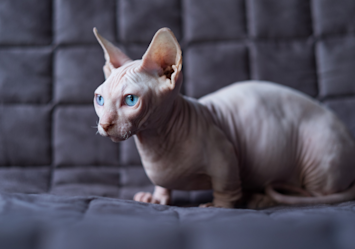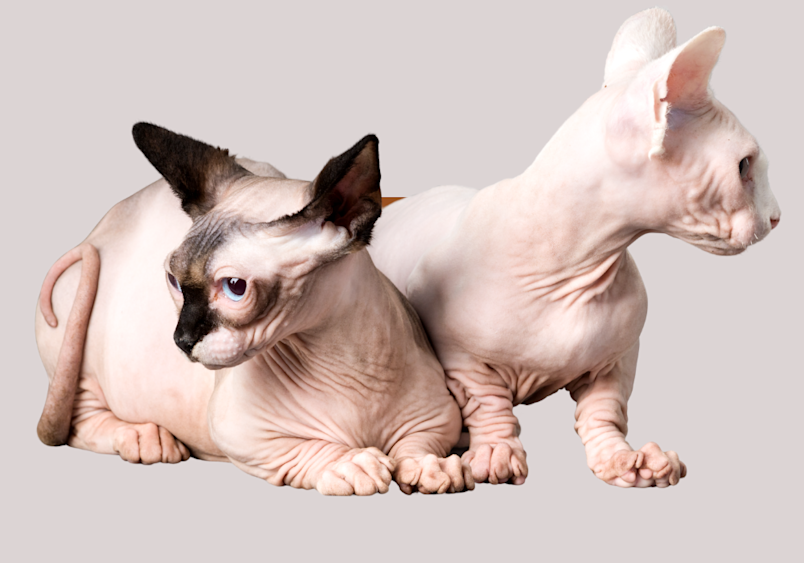
If you’re a true cat afficionado, you’ve almost certainly heard of breeds like the Maine Coon or Siamese. But have you heard of a Bambino cat? If not, you’ll be forgiven for not being acquainted with this charming cat breed since it’s one of the newest in the world!
What is a Bambino cat? The word “Bambino” is Italian for “child” or “baby”, and one glance at a Bambino cat and you’ll understand how they got their name! These distinctive cuties are instantly recognizable thanks to their lack of fur and short, stubby legs, giving them the appearance of a “baby-like” feline. Occasionally known as a Munchkin-Sphynx cat or Bambino Sphynx, these cats are popular yet controversial.
Let’s explore the world of the Bambino cat and learn what veterinarians and cat lovers say about this fascinating new breed!
What is a Bambino Cat?
The Bambino is a cross between a Sphynx cat and Munchkin cat. Some people mistakenly think the Bambino is simply a hairless Munchkin cat, but this is not the case. To be considered a true, purebred Bambino, a cat must be born at least three generations after the initial (F1) crossbreeding of the Sphynx and Munchkin cat.
The Bambino cat first appeared in 2005 when Stephanie and Pat Osborne bred a Sphynx-Munchkin mix that joined their Holy Moly Cattery. Because of the Bambino’s recent origins, you won’t yet find this breed on many “official” lists from groups like the Cat Fanciers’ Association. That doesn’t mean Bambino cats won’t one day find their way into those official organizations!
Unique Physical Characteristics of the Bambino Cat
The very first thing you’ll notice about a Bambino cat is their complete lack of fur. This is thanks to their Sphynx heritage, which also typically gives the Bambino its characteristically large ears and “lemon-shaped” eyes.
Keep in mind that with any hybrid cat, there is no guarantee of what they will look like. Since Bambino cats are so new, they still vary widely in terms of appearance. However, almost always, a Bambino will not only have virtually no fur, but they’ll also have the short, stubby legs of the Munchkin cat.
The Bambino Sphynx: Understanding the Breed
It’s not just appearance that genetics affect. A cat’s temperament can also be influenced by its parents’ DNA. The Sphynx, known for being affectionate and playful, can pass on these wonderful characteristics to Bambinos.
Similarly, the Munchkin cat’s genetics can also come into play. If a Bambino inherits the Munchkin’s temperament, they’ll typically be unusually active, so owners need to have plenty of toys and cat trees around the home.
Since both the Sphynx and Munchkin breeds are known for being exceptionally social, Bambino cats are generally not only comfortable around humans but actively seek out their attention. Be aware that any cat that has an extremely close bond with their humans can develop separation anxiety. A cat suffering from separation anxiety often displays signs like going to the bathroom outside the litterbox, not eating when their humans are gone, and destroying things around the home (toys, furniture, carpeting, etc.).
Anyone thinking about adopting a Bambino cat should be up to the task of spending plenty of time with them throughout the day. Leaving the radio or television on when you’re gone can also help, as can hiding treats around the house to encourage their hunting instincts when they’re alone.
Controversies and Considerations of the Munchkin Sphynx Cat
Much of the controversy around the Bambino cat revolves around its Munchkin lineage. Munchkins are known for their short stature thanks to uncommonly small legs. This unusual physical trait is thanks to a specific genetic mutation that was bred into them.
Some people have questioned whether it is ethical to intentionally breed cats with such tiny legs. While many Munchkin cats don’t seem to have issues with their legs, others are at risk for developing osteoarthritis, a condition that isn’t only painful but affects a feline’s mobility, too.
Another important consideration for people thinking of getting a Bambino cat is where the animal comes from. Pet mills are an increasing problem around the world, especially when it comes to so-called “designer” animals like the Bambino. While some breeders employ ethical practices to raise their animals, there are far too many that simply force their animals to churn out litter after litter in squalid conditions.
Before purchasing a Bambino cat from a breeder, do your due diligence and research the facility. Arrange a tour of the animal’s home environment and avoid any breeder that is raising animals that seem sickly, dirty, or unhappy. Reviews are your best friend when choosing a breeder, so read them carefully to see how pets fare once they’ve been purchased.

Caring for a Bambino Cat
If you’re thinking of adopting a Bambino cat because you’re looking forward to not having to spend so much time taking care of its coat, think twice. While it’s true you won’t need to brush any fur, you will need to bathe your cat regularly. Hairless cats tend to accumulate a lot of oil on their skin, which can lead to infection if not removed. Additionally, some people are still allergic to these cats, even though they have no fur. A Bambino’s dander and saliva can trigger allergic reactions in these individuals, so allergy-prone cat lovers should take note.
Caring for this breed also involves substantial exercise time. The typical Bambino cat is very active and needs to channel their energy into something other than tearing up couch cushions! Investing in a complex climbing structure for your cat isn’t a bad idea, as they’re sure to get plenty of use out of it. Laser toys can also be an easy way to play with a Bambino, as they’ll burn a ton of energy chasing the light around the home.
The Bambino Cat Lifespan and Health
How long a Bambino cat will live depends on its genetics and other factors, including the quality of food it eats throughout its life and how much exercise it gets. In terms of inheritable factors, one should look at the average lifespans of both the Sphynx and Munchkin to get an idea of the Bambino’s lifespan.
Sadly, Sphynx cats are known for having the shortest lifespans of common breeds, averaging just 6.7 years. However, Munchkin cats tend to live between 12 and 15 years. This means the Bambino cat lifespan tends to be just under 7 years at the shortest but could potentially be over twice as long!
Keeping up to date on your cat’s veterinarian visits can make a big difference in extending their life. All cat breeds are susceptible to certain problems, and the Bambino cat isn’t any different. As we mentioned earlier, osteoarthritis isn’t an uncommon issue in these cats, so you should keep a close on your cat to monitor for signs of pain or discomfort in the joints.
Additionally, the Bambino cat’s Munchkin background can make this hybrid prone to inheriting lordosis. Lordosis occurs when a cat’s spine curves inward and causes strain on the animal’s heart and lungs. On the other hand, their Sphynx side can cause a type of heart disease called hypertrophic cardiomyopathy. Veterinary cardiologists can diagnose the problem via an echocardiogram. While a diagnosis can be alarming for a pet parent, know that hypertrophic cardiomyopathy is often manageable with proper treatment, including medication.
The Benefits of Pet Insurance for Your Bambino
Addressing these potential health issues can lead to significant veterinary expenses. Diagnosing hypertrophic cardiomyopathy often involves an echocardiogram, which can range from $500 to $1,500 and if ongoing medication and cardiac check-ups are necessary, the annual costs could easily be up to $2,000 or more, depending on the severity and treatment plan. Kitten insurance offers a way to manage these unexpected costs, providing a financial safety net that allows you to prioritize your cat's health without undue financial stress.
Newer breeds have limited health information available, which means pet owners may have a harder time recognizing health problems in their cat. This is why it’s especially important to keep your little Bambino on a regular vet schedule.
To help manage these predictable expenses, consider exploring pet wellness plans. Unlike insurance, these plans are designed to reimburse you for routine care services, making it easier to budget for and ensure your cat receives consistent preventative care.
Adopting a Bambino Kitten
Ready to adopt a Bambino kitten? Not so fast! You’ll first need to spend some time learning how to take care of a new kitten. Between four and six weeks old, most cats will be able to eat specially formulated kitten food. Speak with a veterinarian to determine whether your new fluffy friend needs a particular diet, as some cats (including Sphynxes) can have digestive issues.
If you have another cat in the home, make sure they’re both comfortable with each other before allowing them to share the same space. Introducing cats to one another safely and gradually is key to creating peace in the household. Protect your new family member by keeping them in a private area in the home at the start. Then, you can slowly let both cats smell each other through the closed door.
Once they both seem at ease (i.e., no more hissing), you can let the cats view one another through a clear barrier like a window. Eventually, you can try allowing both cats in the same room for increasingly longer periods of time. Most Bambinos warm up to other cats with time and even become friends!
Bambino Cats Are Among the Quirkiest of Pets
The Bambino cat might not look like your everyday feline thanks to their hairless skin and tiny legs, but when it comes down to it, these kitties just want to snuggle and love their owners like most cats! They're social little beings who often bond deeply with their people, bringing a lot of warmth and fun into the home. If you're drawn to something a little different but crave that classic feline companionship, the Bambino might just be the wonderfully unique friend you've been looking for.